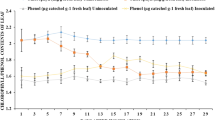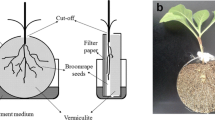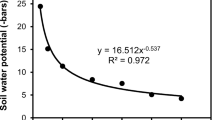Abstract
Tomato plants grown in sand-silica culture in 0.75-liter pots and 50-liter containers were fertilized with three ratios of NH4 +/N03 - percentages: 100/0, 50/50, and 0/100. The seedlings were inoculated with the root-knot nematode,Meloidogyne javanica, and 30 and 60 days after inoculation top and root fresh weights, nematode infection degree and sex ratio of the nematode populations were recorded, and N, P, K analyses of plant tops and roots were conducted.
Nematode development was not influenced by the nutrient treatments but a reduced nematode population per mm of root, and a high percentage of males in the population were associated with the 100% ammonium treatment. Increased nitrate level in the medium enhanced fresh top and root weights in the pots and, especially, in the containers. High levels of N and K in the first month, and of N, P, K in the second month, accumulated in the inoculated roots, particularly in the nitrate-fertilized plants.
The results support the theory of the existence of a metabolic sink in roots ofMeloidogyne-infected plants and suggest an increased tolerance to the root-knot nematode in plants receiving nitrate nutrition.
Similar content being viewed by others
References
Anon. (1976) Fertilizer Use and Plant Health.Proc. 12th Colloq. Int. Potash Inst. (Izmir).
Bergeson, G.B. (1966) Mobilization of minerals to the infection site of root-knot nematodes.Phytopathology 56: 1287–1289.
Bird, A.F. (1970) The effect of nitrogen deficiency on the growth ofMeloidogyne javanica at different population levels.Nematologica 16: 13–21.
Bird, A.F. and Loveys, B.R. (1975) The incorporation of photosynthates byMeloidogyne javanica.J. Nematol. 7: 111–113.
Haque, Q.A., Khan, Abrar M. and Saxena, S.K. (1974) Studies on the effect of different levels of certain elements on the development of root-knot: II. Effect of different levels of potassium on growth and root-knot development on okra, eggplant and tomato.Indian J. Nematol. 4: 25–30.
Haque, Q.A. and Saxena, S.K. (1972) Studies on the effect of different levels of certain elements on the development of root-knot: I. Effect of N, P, K levels on growth of okra and root-knot development.Indian J. Nematol. 2: 35–41.
Hoagland, D.R. and Arnon, D.I. (1938) The water culture method for growing plants without soil.Bull. Calif. Agric. Exp. Stn 347.
Ishibashi, N. and Kondu, E. (1976) Considerations on the role of male adults of root-knot nematodes in the reproduction.Jap. J. Nematol. 6: 35–37.
s’Jacob, J.J. and Bezoijen, J.V. (1977) A Manual for Practical Work in Nematology. Agricultural Univ. of Wageningen, The Netherlands.
Kirkby, E.A. and Hughes, A.D. (1970) Some aspects of ammonium and nitrate nutrition in plant metabolism, pp. 69–77.in: Kirkby, E.A. [Ed.] Nitrogen Nutrition of the Plant. Agricultural Chemistry Symposium, Univ. of Leeds.
Kirkby, E.A. and Knight, A.H. (1977) The influence of the level of nitrate nutrition on ion uptake and assimilation, organic acid accumulation and cation-anion balance in whole tomato plants.Pl. Physiol. 60: 349–353.
Kirkby, E.A. and Mengel, K. (1978) Principles of Plant Nutrition. Int. Potash Inst., Bern.
McClure, M.A. (1977)Meloidogyne incognita: a metabolic sink.J. Nematol. 9: 88–90.
McClure, M.A. and Viglierchio, D.R. (1966) The influence of host-nutrition and intensity of infection on the sex ratio and development ofMeloidogyne incognita in sterile agar cultures of excised cucumber roots.Nematologica 12: 248–258.
Maung, O. (1959) Effect ofMeloidogyne incognita acrita andTrichodorus christiei on the nutrient levels of tomato.Phytopathology 49: 524.
Oteifa, B.A. (1955) Nitrogen source of the host nutrition in relation to infection by a root-knot nematode,Meloidogyne incognita.Pl. Dis. Reptr 39: 902–903.
Owens, R.G. and Novotny, H.M. (1960) Physiological and biochemical studies on nematode galls.Phytopathology 50: 658.
Shafie, M.F. and Jenkins, W.R. (1963) Host parasite relationships ofCapsicum frutescens andPratylenchus penetrans, Meloidogyne incognita acrita andMeloidogyne hapla.Phytopathology 53: 325–328.
Author information
Authors and Affiliations
Rights and permissions
About this article
Cite this article
Spiegel, Y., Cohn, E. & Kafkafi, U. The influence of ammonium and nitrate nutrition of tomato plants on parasitism by the root-knot nematode. Phytoparasitica 10, 33–40 (1982). https://doi.org/10.1007/BF02981890
Received:
Issue Date:
DOI: https://doi.org/10.1007/BF02981890




